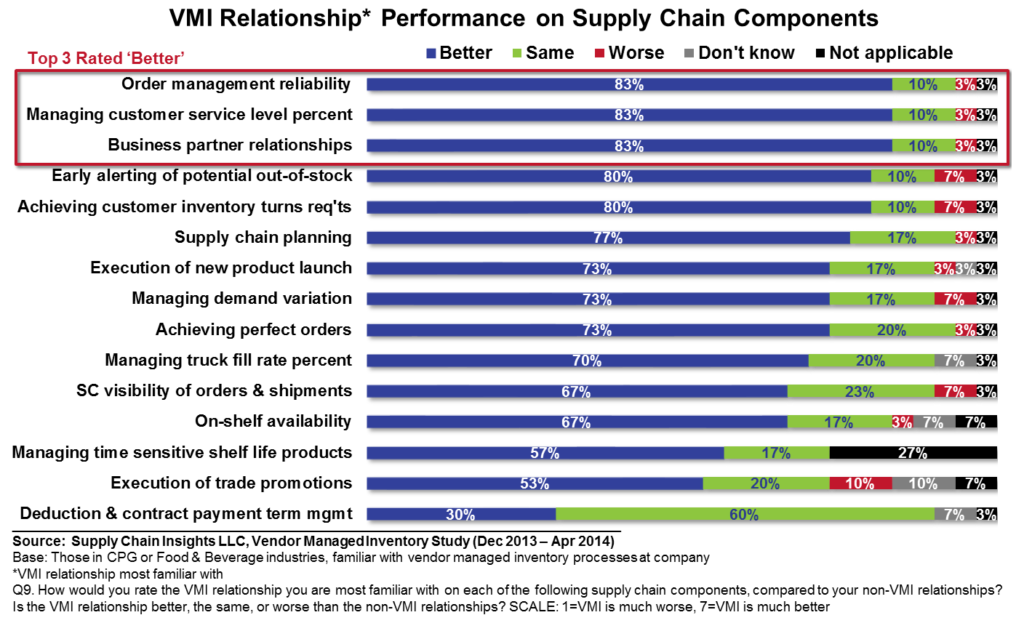sta•sis (ˈsteɪ sɪs, ˈstæs ɪs)
n., pl. sta•ses (ˈsteɪ siz, ˈstæs iz)
the state of equilibrium or inactivity caused by opposing equal force
It was 1988. I was involved in early Vendor Managed Inventory (VMI) pilots. In my work at Clorox we were starting to ship to Walmart using Retail Link. We were excited. It seemed like the start of a great thing. In the pilot, we were able to see retailer flows. We talked furiously about the design of the End-to-End Supply Chain (E2E).
At that time, the conference circuit was buzzing. The words collaboration, Efficient Consumer Response (ECR), Vendor Managed Inventory (VMI), and Collaborative Planning, Forecasting and Replenishment (CPFR) filled the air. The promises were thick. The concepts were right, but the execution was flawed. The processes were overhyped and companies rushed head-over-heels to join the throng.
Today, the average Consumer Packaged Goods (CPG) company has eleven VMI relationships and six VMI planners. Based on the research that we are doing, we can see that the programs are not growing. They are not contracting. Instead, they are caught between sales-driven and supply-driven processes. We have stasis.
While our initial energies were focused on large accounts, today’s VMI programs are getting the best traction in the drug and dollar channels. There are few VMI programs left with Publix, Safeway, Target and Walmart conspicuously absent. Kroger’s movement to Market6 added to the stasis. Companies are shipping fewer and fewer cases using VMI processes.
The programs operate as on an island. Only one company interviewed is actively working on the building of E2E processes, outside-in, connecting the flows of VMI. Ironically, while it is connected to the outside world, it is not well-connected to the manufacturer’s enterprise systems. Most companies’ demand-planning systems do not allow easy integration of retail data; and the connection to the planning systems requires an unwanted redesign that most companies try to avoid.
Figure 1.
Reflections
We are now entering our third decade of managing VMI processes. Most of the programs have been inherited. The teams running them were not part of the overhyped exuberance.
The teams running them are heads-down and in management mode. Most of the VMI processes report through customer service. The technologies are fixed and the processes are tried-and-true. These teams are not actively trying to design End-t0-End flows or synchronize the VMI programs with other demand signals. It just is. VMI has become a reliable part of the order flow.
At Supply Chain Insights, we are in the process of completing a study on VMI that will publish in our May Newsletter. (The study is still open. If you would like to participate and compare your results to those of the industry, just access the VMI Study through this link.) We currently have 35 responses and are trying to drive the response rate to at least 50.
A Head-Scratcher
In the study, the average company reduced the costs of transportation by 3% and reduced the order cycle time by at least a day. And, as shown in Figure 1, the orders are cleaner and more reliable. Customer service levels improve. So, why if the process reduces costs, improves order cycle times, and order reliability, are we not driving greater adoption? These preliminary results make me scratch my head. Why are we at a stasis? Why are we not taking advantage of VMI more actively? I think the answer lies in the fact that the program is juxtaposed between the opposing forces of sales and supply. When companies become market-driven and understand the differences between a sales-driven approach and a market-driven value chain, the processes take on greater value. The mapping of flows outside-in and horizontally across the company enables greater value.
The more research that I do, the more I scratch my head. The CPG organizations talk more about collaboration than other industries, but they have made less progress than high-tech and electronics or A&D’s work on Performance-based Logistics (PBL). We have had a lot of talk and flurry over initiatives, but we are at a stasis.
What do you think? I would love your thoughts. Why is VMI at a stasis?







